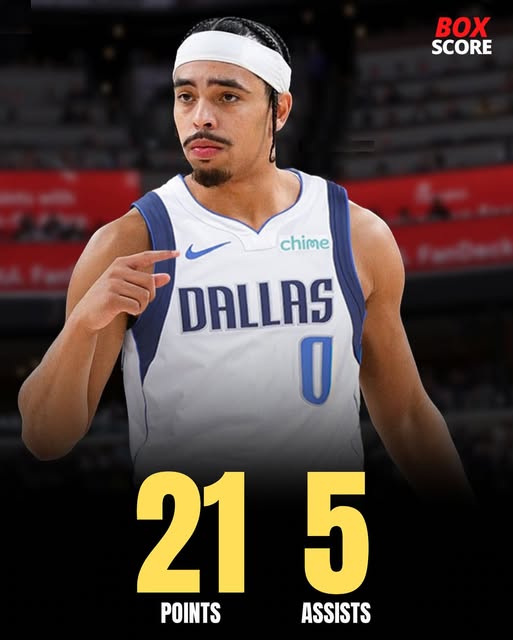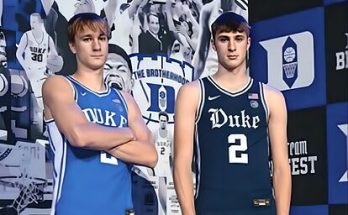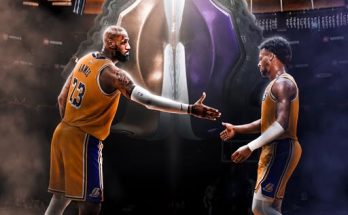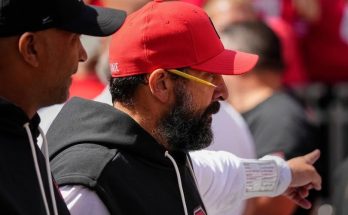Dallas Mavericks fans were met with unexpected news when reports emerged that young center Dereck Lively II had undergone surgery to clean up bone spurs in his right foot. According to ESPN’s Shams Charania, the procedure was described as a cleanup surgery, a term often used when referring to relatively minor operations intended to relieve chronic discomfort and prevent more serious complications. For Mavericks supporters and NBA observers alike, this development carries both immediate and long-term implications—not just for Lively’s personal trajectory, but also for the Mavericks’ plans moving into the upcoming season.
Dereck Lively II has quickly become one of the most promising young big men in the NBA. After being selected with the 12th overall pick in the 2023 NBA Draft by the Oklahoma City Thunder and subsequently traded to Dallas as part of the package involving Davis Bertans and other assets, Lively wasted no time showcasing his worth. In his rookie season, he impressed with his rim protection, rebounding, and hustle—all critical traits the Mavericks had been desperately missing in the frontcourt.
Lively’s ability to defend the paint and his emerging pick-and-roll chemistry with superstar Luka Dončić provided Dallas with a newfound interior presence. His footwork, timing, and instincts allowed him to challenge shots effectively without fouling, and his vertical spacing on offense helped open the floor for the Mavericks’ perimeter weapons. At just 20 years old, his development curve was ahead of schedule, and his impact on the court was undeniable.
The announcement of the foot surgery comes as a precautionary measure rather than a panic-inducing red flag. Bone spurs, especially in the feet, are not uncommon among professional basketball players. They form as small, bony projections along the edges of bones, typically where bones meet each other in joints. In Lively’s case, the affected area is his right foot—an essential body part for any player, but particularly for a big man who constantly relies on foot positioning, quick lateral movement, and leaping ability.
Bone spurs can be caused by several factors, including stress, repetitive motion, or inflammation over time. In athletes, the demand placed on the body during games and practices—especially during long NBA seasons—can accelerate wear and tear. Over time, calcium deposits can build up in areas of chronic irritation, which may not initially cause pain but can lead to reduced mobility, stiffness, and eventually, discomfort or further injury if left untreated.
Surgery to remove or clean up bone spurs is typically done arthroscopically, a minimally invasive procedure involving small incisions and the use of a camera and specialized tools. The goal is to shave down or remove the bony overgrowths that are causing pain or interfering with joint function. Recovery time varies depending on the severity of the spurs and the overall health of the athlete, but it generally spans several weeks to a few months.
According to reports, Lively is expected to make a full recovery ahead of training camp, which suggests the team and his medical staff believe this is a routine cleanup rather than a significant medical setback. That’s good news for Dallas, especially considering how vital Lively is to their defensive schemes. His presence in the paint not only deters drives and changes shot trajectories but also allows perimeter defenders to play more aggressively, knowing they have a reliable backstop behind them.
Still, anytime a young player’s foot is involved in surgery, it’s worth paying attention. The history of big men and foot injuries in the NBA is both well-documented and, at times, worrisome. Players like Yao Ming, Greg Oden, and even Joel Embiid early in his career experienced significant setbacks due to foot issues. The foot, being a complex structure of bones, tendons, ligaments, and cartilage, is especially susceptible to stress-related injuries in athletes who carry a lot of weight and engage in constant jumping and pivoting.
But there’s also reason for optimism in Lively’s case. First, the Mavericks’ medical and training staff have become increasingly proactive in recent years, focusing on preventative care and long-term health rather than simply reacting to injuries after they occur. This move may very well be a result of ongoing monitoring that identified the bone spurs early enough to act decisively before they escalated into something more debilitating.
Second, Lively has shown a high level of professionalism and commitment to his physical conditioning. Throughout his rookie campaign, he maintained his energy levels and was rarely caught out of position—both signs of a player who takes care of his body and studies the game diligently. If he approaches his rehab with the same intensity and focus, there’s no reason to believe he won’t return even stronger.
For the Mavericks as a team, Lively’s availability next season is critical. Dallas is coming off a deep playoff run, and their aspirations are higher than ever. With Luka Dončić and Kyrie Irving at the helm, the team has offensive firepower in abundance. But what has often held them back in past seasons was their inability to protect the rim and control the glass—areas where Lively was a game-changer.
In games where Lively was on the floor, Dallas often looked like a different team defensively. His ability to switch on smaller players, recover quickly, and contest shots without fouling allowed the Mavericks to employ more aggressive defensive schemes. Additionally, his offensive rebounding provided valuable second-chance points, and his ability to catch and finish lobs made him a reliable scoring option in transition and in half-court sets.
The timing of the surgery also suggests Dallas is planning with the long-term in mind. Rather than risk further complications by letting Lively play through discomfort, they chose the route that prioritizes his future health. It’s a mature, forward-thinking approach that reflects the franchise’s investment in Lively as a cornerstone piece.
Lively’s absence during offseason training and potential limitations during preseason may slightly affect his rhythm and conditioning. However, given that he’s entering just his second year and already has a solid understanding of the team’s system, the adjustment period should be minimal. More importantly, the surgery may help eliminate lingering issues that could have hampered his performance in the future.
It’s also worth examining how the Mavericks will handle Lively’s minutes and usage post-recovery. With the rigors of an 82-game season and the playoffs in mind, the coaching staff may opt for a more cautious approach to his minutes early on. This could mean a bigger role for backup centers or even small-ball lineups, depending on matchups.
Dallas could also look to add depth in the frontcourt, whether through free agency, trades, or the development of young players already on the roster. Having another reliable big to share the load would reduce pressure on Lively and ensure he doesn’t return too quickly or overextend himself during his recovery phase.
The news of Lively’s surgery also serves as a reminder of the physical toll that professional basketball takes on players—especially big men who are constantly battling in the paint. Despite being just a year into his NBA journey, Lively’s experience underscores the importance of regular health evaluations, smart workload management, and the evolving role of sports science in today’s game.
From a fan perspective, this development may seem like a small bump in the road. And truthfully, that’s what the Mavericks hope it will be—a minor detour rather than a long-term obstacle. But it also provides a glimpse into the careful balance that teams must maintain between short-term success and long-term player health.
For Lively, this could be a pivotal moment in his development. How he responds mentally and physically to this minor setback will be watched closely. But if his rookie season is any indication, the young center has the maturity, discipline, and drive to turn this challenge into a springboard for greater growth.
As the NBA increasingly leans toward positionless basketball and versatile big men, Lively’s role becomes even more crucial. His ability to adapt, stay healthy, and continue developing his offensive skill set will determine just how high his ceiling really is. A healthy Lively with a more refined post game, improved free-throw shooting, and continued defensive dominance could become one of the premier centers in the league.
In closing, while foot surgeries are never ideal, the circumstances surrounding Dereck Lively II’s procedure suggest that the Mavericks are being proactive and strategic. The team, player, and medical staff all appear aligned in ensuring that Lively not only returns to the court but does so in a way that supports his long-term success and durability.
As the NBA offseason progresses and training camp approaches, all eyes will be on Lively’s progress. His return to full health will be a critical storyline for the Mavericks as they seek to build upon the promise of last season and make a deeper push toward championship contention. If he bounces back as expected, this brief pause in his journey could eventually be remembered not as a setback, but as a necessary step in the making of a star.



